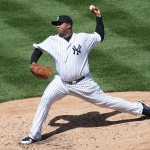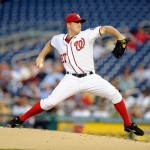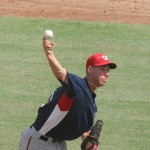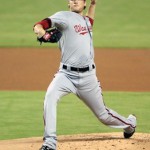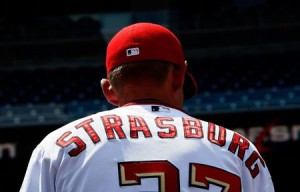Some of my favorite trivia questions revolves around Opening Day Starters. With another Opening Day in the books, here’s some useless trivia related to Opening Day starters. I’ve updated my Opening Day Starters spreadsheet to Google Docs and created a link in the “Nationals Arm Race creation” section along the right. Fyi, on a team-by-team basis you can query Baseball-Reference.com for the opening day lineups (here’s the Washington/Montreal franchise’ opening day lineup history as an example).
Current Active Leaders in Opening Day Starts
| 11 | CC Sabathia |
| 9 | Mark Buehrle |
| 7 | Felix Hernandez |
| 7 | Justin Verlander |
| 6 | Bartolo Colon |
| 6 | Tim Hudson |
| 6 | Jered Weaver |
| 6 | James Shields |
| 5 | Josh Beckett |
| 5 | Yovanni Gallardo |
| 4 | Jake Peavy |
| 4 | Tim Lincecum |
| 4 | Clayton Kershaw |
| 4 | Jon Lester |
| 3 | Strasburg, Cueto, Wainwright, Price, Masterson, Nolasco |
| 2 | Lee, Samardzija, Liriano, Dickey, Sale, Feldman |
Those players bolded in the list above had 2014 opening day starts and added to their totals. (Note; there’s plenty of guys out there with 2 or 3 opening day starts but who did not extend their count in 2014; they are not included here). With the retirement of Roy Halladay, CC Sabathia extends his active lead in this category. Mark Buehrle has given over the reigns of opening day starter possibly for good, based on his standing in the Toronto rotation. Meanwhile the next closest competitors (Justin Vernalder and Felix Hernandez) could eventually supplant Sabathia, especially if he continues to struggle and gets replaced as the Yankees’ ace.
Felix Hernandez and Justin Verlander continue to be the best bets to broach the all-time records (see below) based on their ages, their current counts and their new long-term contracts.
Answers to other Opening Day start trivia:
Current Active Leader in consecutive Opening Day Starts: Sabathia with 9 consecutive, split among two teams. Second is Verlander with 7 straight, albeit all with the same team. There was talk about how his Cy Young-winning rotation mate Max Scherzer should have gotten the ball this year, given Verlander’s 2013 struggles.
Most ever Opening Day Starts all-time: Tom Seaver with 16 in his career.
Most ever Consecutive Opening Day Starts: Hall of Fame lightning rod Jack Morris, who made 14 straight such starts.
Number of first-time opening day starters in 2014: Ten (10) guys got the ball on opening day for the first time, slightly down from last year’s 13. Injuries gave some pitchers the ball on opening day over other expected rotation mates (this is definitely the case with the likes of Julio Teheran, Tanner Scheppers, Sonny Gray, Dillon Gee, Jorge De La Rosa), and its probably the case that others got the ball on opening day thanks to their own personal ascention to the “lead-dog” spot on their teams (Jose Fernandez, Madison Bumgarner). The other three newbies (Andrew Cashner, Wade Miley, and Chris Tillman) probably fall somewhere inbetween these categories.
Who seems most likely to break Seaver or Morris’ Records at this point? Still Sabathia, who already has 11 opening day starts (and 9 straight), is the #1 in New York, is only 32 and still has four years on his current deal. However, he took a big step backwards in 2013 performance-wise, and the Yankees spent a ton of money on Masahiro Tanaka, and there could be a passing of the torch if Tanaka blows it out in 2014. Meanwhile Hernandez already has 7 opening day starts, just signed a deal that takes him through 2019 with a relatively easy option for 2020. That’s many more seasons under contract and he’d only be 34 years of age by its end. He could be the standard holder if he stays healthy and continues to pitch like an ace.
Most Inconsisent team using Opening Day Pitchers: Oakland. They’ve used 9 different opening day starters in the last 9 seasons, and that’s likely to continue since both the candidates for this year had injuries that forced them to go to a rookie for 2014. Pittsburgh is right behind them; they have used 7 different opening day starters in the last 7 seasons, and 13 different starters in the last 15 seasons. The Nats have at some point employed no less than three former Pittsburgh opening day starters: Ron Villone, Oliver Perez and Zach Duke. Colorado, Baltimore and Minnesota have also struggled for most of the past decade to find a dominant, reliable “Ace” and constantly cycle through new opening day starters, and once again each is using a different guy in 2014.
